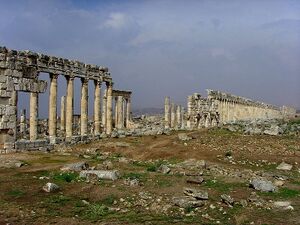Category:Lebanese recipes

In this category you will find recipes from the Lebanon. Lebanese cuisine includes an abundance of starches, fruits, vegetables, fresh fish and seafood; animal fats are consumed sparingly. Poultry is eaten more often than red meat, and when red meat is eaten it is usually lamb on the coast and goat meat in the mountain regions. It also includes copious amounts of garlic and olive oil, often seasoned by lemon juice. Rarely a meal goes by in Lebanon that does not include these ingredients. Most often foods are either grilled, baked or sautéed in olive oil; butter or cream is rarely used other than in a few desserts. Vegetables are often eaten raw or pickled as well as cooked. While the cuisine of Lebanon doesn't boast an entire repertoire of sauces, it focuses on herbs, spices and the freshness of ingredients; the assortment of dishes and combination are almost limitless. The meals are full of robust, earthy flavours and, like most Mediterranean countries, much of what the Lebanese eat is dictated by the seasons.
In Lebanon, very rarely are drinks served without being accompanied by food. One of the more healthy aspects of Lebanese cuisine is the manner or custom in which their food is often served, it's referred to as mezze. Similar to the tapas of Spain and antipasti of Italy, mezze are an array of small dishes placed before the guests creating an array of colours, flavours, textures and aromas. This style of serving food is less a part of family life than it is of entertaining and cafés. Mezze may be as simple as pickled vegetables, hummus and bread, or it may become an entire meal consisting of grilled marinated seafood, skewered meats, a variety of cooked and raw salads and an arrangement of desserts.
Although simple fresh fruits are often served towards the end of a Lebanese meal, there is also dessert and coffee.
A unique cultural past has helped make Lebanese food the most popular of all Middle Eastern cuisines. For most of its past, Lebanon has been ruled by foreign powers that have influenced the types of food the Lebanese ate. From 1516 to 1918, the Ottoman Turks controlled Lebanon and introduced a variety of foods that have become staples in the Lebanese diet, such as cooking with lamb. After the Ottomans were defeated in World War I (1914–1918), France took control of Lebanon until 1943, when the country achieved its independence. During this time, the French introduced some of their most widely eaten foods, particularly treats such as flan, a caramel custard dessert dating back to the 1500s, and buttery croissants. The Lebanese themselves have also helped bring foods of other cultures into their diet. Ancient tribes journeyed throughout the Middle East, carrying with them food that would not spoil easily, such as rice and dates.
Family cuisine offers also a range of dishes, such as stews or Yakhnis, which can be cooked in many forms depending on the ingredients used and are usually served with meat and rice vermicelli. The Lebanese flat pitta bread is essential to every Lebanese meal, and can be used to replace the usage of the fork. Arak, an flavoured liqueur, is the Lebanese national alcoholic drink and is usually served with the traditional convivial Lebanese meals. Another drink is Lebanese wine, which is now enjoying a worldwide reputation. Known among the great variety of Lebanese desserts, are pastries such as Baklava, the Lebanese ice cream with its oriental flavours. Social events play a significant role in Lebanese gastronomy, as some dishes are particularly prepared on special occasions: the Meghli dessert, for instance is served to celebrate a newborn baby in the family.
LEBANESE RECIPES
Pages in category ‘Lebanese recipes’
The following 36 pages are in this category, out of 36 total.